|
Murgunstrumm And Others
''Murgunstrumm and Others'' is a collection of horror short stories by author Hugh B. Cave. It was released in 1977 by Carcosa in an edition of 2,578 copies of which the 597 copies, that were pre-ordered, were signed by the author and artist. Many of the stories originally appeared in the magazines ''Strange Tales of Mystery and Terror'', ''Weird Tales'', ''Spicy Mystery Stories'', ''Ghost Stories'', ''Thrilling Mysteries'', ''Black Book Detective Magazine'', '' Argosy'', ''Adventure'', ''Ellery Queen's Mystery Magazine'' and '' Whispers''. It has since been reissued by Wildside Press in trade paperback and hardcover. Awards *1978, World Fantasy Award, Best Collection/Anthology. Contents * Foreword * "Murgunstrumm" * "The Watcher in the Green Room" * "The Prophecy" * "The Strange Death of Ivan Gromleigh" * "The Affair of the Clutching Hand" * "The Strange Case of No. 7" * "The Isle of Dark Magic" * "The Whisperers" * "Horror in Wax" * "Prey of the Nightborn" * "Maxon’s Mis ... [...More Info...] [...Related Items...] OR: [Wikipedia] [Google] [Baidu] |
Hugh B
Hugh may refer to: *Hugh (given name) Noblemen and clergy French * Hugh the Great (died 956), Duke of the Franks * Hugh Magnus of France (1007–1025), co-King of France under his father, Robert II * Hugh, Duke of Alsace (died 895), modern-day France * Hugh of Austrasia (7th century), Mayor of the Palace of Austrasia * Hugh I, Count of Angoulême (1183–1249) * Hugh II, Count of Angoulême (1221–1250) * Hugh III, Count of Angoulême (13th century) * Hugh IV, Count of Angoulême (1259–1303) * Hugh, Bishop of Avranches (11th century), France * Hugh I, Count of Blois (died 1248) * Hugh II, Count of Blois (died 1307) * Hugh of Brienne (1240–1296), Count of the medieval French County of Brienne * Hugh, Duke of Burgundy (d. 952) * Hugh I, Duke of Burgundy (1057–1093) * Hugh II, Duke of Burgundy (1084–1143) * Hugh III, Duke of Burgundy (1142–1192) * Hugh IV, Duke of Burgundy (1213–1272) * Hugh V, Duke of Burgundy (1294–1315) * Hugh Capet (939–996), King of France * ... [...More Info...] [...Related Items...] OR: [Wikipedia] [Google] [Baidu] |
Lee Brown Coye
Lee Brown Coye (July 24, 1907 – September 5, 1981) was an American artist. Coye is probably best remembered for his black-and-white illustrations for pulp magazines and horror fiction, but he produced a variety of works in other media. Biography Coye was born in Syracuse, New York, and as a young man lived in nearby Tully (town), New York, Tully. He spent his entire life in the Central New York area. He and his wife, Ruth, lived in Syracuse for many years where Coye's activities included teaching adult art classes; working under the Works Progress Administration to paint a mural in the Cazenovia High School in 1934 (since destroyed); advertising for the WSYR (AM), WSYR Broadcasting System in upstate New York, producing a variety of commissioned works. The Coyes settled in Hamilton (village), New York, Hamilton, New York, in 1959 when Lee went to work for Sculptura, a small company that reproduced antique sculptures. The move to Hamilton allowed Coye to fulfill his ambition of ... [...More Info...] [...Related Items...] OR: [Wikipedia] [Google] [Baidu] |
Horror Fiction
Horror is a genre of fiction which is intended to frighten, scare, or disgust. Horror is often divided into the sub-genres of psychological horror and supernatural horror, which is in the realm of speculative fiction. Literary historian J. A. Cuddon, in 1984, defined the horror story as "a piece of fiction in prose of variable length... which shocks, or even frightens the reader, or perhaps induces a feeling of repulsion or loathing". Horror intends to create an eerie and frightening atmosphere for the reader. Often the central menace of a work of horror fiction can be interpreted as a metaphor for larger fears of a society. Prevalent elements of the genre include ghosts, demons, vampires, werewolves, ghouls, the Devil, witches, monsters, extraterrestrials, dystopian and post-apocalyptic worlds, serial killers, cannibalism, cults, dark magic, satanism, the macabre, gore and torture. History Before 1000 The horror genre has ancient origins, with roots in folklore ... [...More Info...] [...Related Items...] OR: [Wikipedia] [Google] [Baidu] |
Short Stories
A short story is a piece of prose fiction that typically can be read in one sitting and focuses on a self-contained incident or series of linked incidents, with the intent of evoking a single effect or mood. The short story is one of the oldest types of literature and has existed in the form of legends, mythic tales, folk tales, fairy tales, tall tales, fables and anecdotes in various ancient communities around the world. The modern short story developed in the early 19th century. Definition The short story is a crafted form in its own right. Short stories make use of plot, resonance, and other dynamic components as in a novel, but typically to a lesser degree. While the short story is largely distinct from the novel or novella/short novel, authors generally draw from a common pool of literary techniques. The short story is sometimes referred to as a genre. Determining what exactly defines a short story has been recurrently problematic. A classic definition of a short story i ... [...More Info...] [...Related Items...] OR: [Wikipedia] [Google] [Baidu] |
Carcosa
Carcosa is a fictional city in Ambrose Bierce's short story "An Inhabitant of Carcosa" (1886). The ancient and mysterious city is barely described and is viewed only in hindsight (after its destruction) by a character who once lived there. American writer Robert W. Chambers borrowed the name "Carcosa" for his stories, inspiring generations of authors to similarly use Carcosa in their own works. ''The King in Yellow'' The city was later used more extensively in Robert W. Chambers' book of short horror stories published in 1895, titled ''The King in Yellow''. Chambers had read Bierce's work and borrowed a few additional names from his work, including #Associated names, Hali and Hastur. In Chambers' stories, and within the apocryphal play titled ''The King in Yellow'', which is mentioned several times within them, the city of Carcosa is a mysterious, ancient, and possibly cursed place. The most precise description of its location is the shores of Lake Hali, either on another planet, ... [...More Info...] [...Related Items...] OR: [Wikipedia] [Google] [Baidu] |
Strange Tales 193301
Strange may refer to: Fiction * Strange (comic book), a comic book limited series by Marvel Comics * Strange (Marvel Comics), one of a pair of Marvel Comics characters known as The Strangers * Adam Strange, a DC Comics superhero * The title character of the television series ''The Journey of Allen Strange'' * Doc Strange, a Thrilling Comics character * Doctor Strange, a Marvel Comics character ** Stephen Strange (Marvel Cinematic Universe), a film character based on the comic book character * Hugo Strange, a DC Comics character * Jonathan Strange, a magician in the novel '' Jonathan Strange & Mr Norrell'' by Susanna Clarke and the miniseries adaptation Music * ''Strange'' (video), a compilation of music videos by Depeche Mode * Strange Music, a record label founded by Travis O'Guin and rapper Tech N9ne Songs * "Strange" (Celeste song), 2019 * "Strange" (En Vogue song), 1991 * "Strange" (Miranda Lambert song), 2022 * "Strange" (Reba McEntire song), 2009 * "Strange" (Wet ... [...More Info...] [...Related Items...] OR: [Wikipedia] [Google] [Baidu] |
1977 In Literature
This article contains information about the literary events and publications of 1977. Events *February 20 – An episode of '' Doctor on the Go'', co-written by Douglas Adams and Graham Chapman, marks the beginning of Adams' career as a writer for BBC radio. *March 4 – Andrés Caicedo commits suicide by overdose, aged 25, about a month after the publication of his novel '' ¡Que viva la música!'' ("Let Music Live!", translated as ''Liveforever'') is published in his hometown of Cali, Colombia. * April 27 – Héctor Germán Oesterheld, Argentine comic book writer born 1919), is kidnapped by the military authorities; he is believed to have died in detention a few months later. *July 11 – The English magazine ''Gay News'' is found guilty of blasphemous libel for publishing a homoerotic poem, "The Love That Dares to Speak Its Name" by James Kirkup, in a case (''Whitehouse v Lemon'') at the Old Bailey in London, on behalf of Mary Whitehouse's National Viewers and Listeners Ass ... [...More Info...] [...Related Items...] OR: [Wikipedia] [Google] [Baidu] |
Weird Tales
''Weird Tales'' is an American fantasy and horror fiction pulp magazine founded by J. C. Henneberger and J. M. Lansinger in late 1922. The first issue, dated March 1923, appeared on newsstands February 18. The first editor, Edwin Baird, printed early work by H. P. Lovecraft, Seabury Quinn, and Clark Ashton Smith, all of whom went on to be popular writers, but within a year, the magazine was in financial trouble. Henneberger sold his interest in the publisher, Rural Publishing Corporation, to Lansinger, and refinanced ''Weird Tales'', with Farnsworth Wright as the new editor. The first issue under Wright's control was dated November 1924. The magazine was more successful under Wright, and despite occasional financial setbacks, it prospered over the next 15 years. Under Wright's control, the magazine lived up to its subtitle, "The Unique Magazine", and published a wide range of unusual fiction. Lovecraft's Cthulhu mythos stories first appeared in ''Weird Tales'', starti ... [...More Info...] [...Related Items...] OR: [Wikipedia] [Google] [Baidu] |
Argosy (magazine)
''Argosy'', later titled ''The Argosy'', ''Argosy All-Story Weekly'' and ''The New Golden Argosy'', was an American pulp magazine from 1882 through 1978, published by Frank Munsey until its sale to Popular Publications in 1942. It is the first American pulp magazine. The magazine began as a children's weekly story–paper entitled ''The Golden Argosy''. In the era before the Second World War, ''Argosy'' was regarded as one of the "Big Four" pulp magazines (along with ''Blue Book'', ''Adventure'' and ''Short Stories''), the most prestigious publications in the pulp market, that many pulp magazine writers aspired to publish in.Lee Server, ''Danger Is My Business: an illustrated history of the Fabulous Pulp Magazines''. San Francisco: Chronicle Books. (1993) (pp. 22-6, 50) John Clute, discussing the American pulp magazines in the first two decades of the twentieth century, has described ''The Argosy'' and its companion ''The All-Story'' as "the most important pulps of their er ... [...More Info...] [...Related Items...] OR: [Wikipedia] [Google] [Baidu] |
Adventure (magazine)
''Adventure'' was an American pulp magazine that was first published in November 1910Robinson, Frank M. & Davidson, Lawrence ''Pulp Culture – The Art of Fiction Magazines''. Collectors Press Inc 2007 (p. 33-48). by the Ridgway company, an subsidiary of the Butterick Publishing Company. ''Adventure'' went on to become one of the most profitable and critically acclaimed of all the American pulp magazines."No. 1 Pulp" ''''. The magazine had 881 issues. Its first editor was Trumbull White, he was succeeded in 1912 by |
Ellery Queen's Mystery Magazine
''Ellery Queen's Mystery Magazine'' is a bi-monthly American digest size fiction magazine specializing in crime fiction, particularly detective fiction, and mystery fiction. Launched in fall 1941 by Mercury Press, ''EQMM'' is named after the fictitious author Ellery Queen, who wrote novels and short stories about a fictional detective named Ellery Queen. From 1993, EQMM changed its cover title to be ''Ellery Queen Mystery Magazine'' (without the 's), but the table of contents still retains the full name. Background Ellery Queen was the pseudonym of the team of Frederic Dannay and Manfred B. Lee, who had been writing under the name since 1929. ''EQMM'' was created to provide a market for mystery fiction above the common run of pulp crime magazines of the day. Dannay served as the magazine's editor-in-chief (although still under the name Ellery Queen) from its creation until his death in 1982, when managing editor Eleanor Sullivan succeeded to the post. Following her death in 199 ... [...More Info...] [...Related Items...] OR: [Wikipedia] [Google] [Baidu] |
Whispers (Magazine/Anthologies)
''Whispers'' was one of the new horror and fantasy fiction magazines of the 1970s. History Named after a fictitious magazine referenced in the H. P. Lovecraft story " The Unnamable", ''Whispers'' began as an attempt by editor and publisher Stuart David Schiff to produce a modest semi-professional little magazine that hoped to revive the legendary ''Weird Tales'' in a small way. The magazine was also a followup to August Derleth's The Arkham Collector, which had ceased after Derleth's death. ''Whispers'' was first published in July 1973. It went on to become a more elaborate showcase for dark fantasy fiction and artwork of the 1970s. Schiff's early influences included the story of Aladdin, the Gorgon and the Cyclops, Edgar Allan Poe, Weird Tales and Lee Brown Coye. He subsequently became an avid collector of horror books and materials. Among the fiction writers featured in the magazine were Manly Wade Wellman, Fritz Leiber, Robert Bloch, Ramsey Campbell, and Karl Edward Wagner ... [...More Info...] [...Related Items...] OR: [Wikipedia] [Google] [Baidu] |




